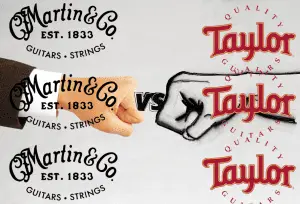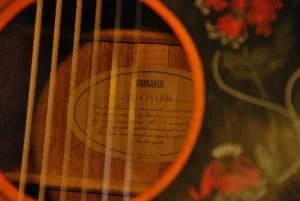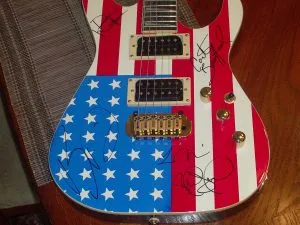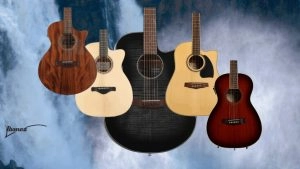No guitar collection is complete without an acoustic guitar. It doesn’t matter if you’re new to playing guitar or a seasoned musician—a quality acoustic guitar is an essential piece for practice and performance. As we go through this list of the best acoustic guitars, you’ll find that you don’t need to pay a premium to purchase a quality musical instrument. The best acoustic guitar to learn on is the one in your possession!

Not long ago, it was widely accepted that imported or lower-priced instruments were subpar from a quality and playability perspective. However, this rundown of the best acoustic guitars proves that you can find smooth playability and quality components at all price points — regardless of brand or where these acoustic guitars are manufactured.
On a tight budget? Fret not — check out our ‘best cheap acoustic guitars’ article.
But don’t worry — the instruments on this list are the best acoustic guitar
If you’re dreaming of owning the best acoustic guitar with quality tonewoods, onboard electronics, beautiful aesthetics, and the latest and greatest features, we’ve got you covered here as well.
As you embark on your mission to find the best acoustic guitar for you, we’ve done the legwork to find the best acoustic guitars for virtually every player on every budget. Let’s dive in and help you find a new acoustic guitar.
Full Reviews
This rundown aims to offer something for everyone — whether you’re looking to purchase your first acoustic guitar or add to your collection, starting with the best acoustic guitars in the budget range and working our way up to the more expensive models.
Best Acoustic Guitars — Budget
Nowadays, the quality and playability of “budget” guitars have increased dramatically. These affordable acoustic guitars make a great beginner guitar or backup for seasoned musicians.
Fender CC-60S Concert (Pack)

The Fender CC-60S Concert Pack includes everything you need to get started on an acoustic guitar: A very playable and affordable acoustic guitar with a gig bag, strap, and strings. You also receive a 3-month Fender Play subscription that lets you tap into video lessons and other educational resources if you’re just starting.
For less than $300, the Fender CC-60S packs a lot of guitar into a small and affordable package. Featuring a concert-sized body that’s smaller and easier to play, especially for younger guitarists, it’s similar to its larger sibling — the Fender CD-60S — but actually better for fingerpicking.
The CC-60S has a solid spruce top with a killer black finish, laminated mahogany back and sides, walnut bridge and fingerboard, and a nato neck. The “easy to play” neck lives up to its name thanks to rolled fretboard edges that are very comfortable to play.
- Concert guitar body shape. Comfortable size for younger players and beginners
- Rolled edges on neck. Comfortable and easy to play
- Everything you need to get started. The bundle includes a gig bag, strap, guitar strings, and more.
- Tonewoods. Laminated back and sides may turn off some players.
Acoustic guitar purists might turn their noses up at the laminated back and sides — laminated woods are typically cheaper and less desirable on acoustic guitars. This shouldn’t come as a big surprise, as more affordable acoustic guitars typically scale back on specific features. But for $259 and a bevy of accessories, the Fender CC-60S is a great value that plays well and sounds great.
Whether you’re a beginner who wants to safely transport your guitar to lessons or an experienced player who wants a travel (or backup) guitar, the CC-60S Concert Pack has everything you need to hit the road.
• • •
Epiphone DR-100

The Epiphone DR-100 is Epiphone’s best-selling acoustic guitar for a good reason. The DR-100 packs in a solid selection of tonewoods with a very comfortable neck, making this a great first — or second — acoustic guitar.
The Epiphone DR-100 features a “select” spruce top paired with mahogany back and sides. Through this classic combination, you get the bright and high-definition tone that spruce is known for, along with the depth and low-end response from the mahogany.
One of our favorite features of the Epiphone DR-100 is the slim-taper neck. This is essentially the “Goldilocks” of neck shapes: Not too wide or not too narrow. It’s really comfortable and easy to play.
- Solid tonewood selections. Spruce top and mahogany back and sides sound great
- Great neck. Slim taper neck shape is very comfortable
- Three killer finishes. Vintage sunburst, natural and ebony finishes all look great.
- Lower quality components. I’d recommend getting a professional setup at your local guitar shop to maximize your value.
Let’s not forget about the low price tag on the Epiphone DR-100. For $169, you get your choice between three great-looking finishes (Vintage Sunburst, Natural, and Ebony) with solid tonewoods and a very comfortable neck.
At the end of the day, this is still a lower-end guitar, and you might not be completely thrilled with the quality of all of the components. I always recommend a pro setup whenever you buy a new guitar, but I’d strongly advise it here.
Minor adjustments can make the Epiphone DR-100 a true workhorse acoustic guitar for less than $200. Epiphone may be known for its low-cost acoustic guitars, but don’t let that scare you away. Out of the box, the DR-100 is one of the best acoustic guitars on the market today for the money, and it’s one of my favorite acoustic guitars for beginners.
• • •
Yamaha FG830 Dreadnought

The Yamaha FG830 is an upgraded entry into the world’s best-selling acoustic guitar series. Carrying on the legacy of the FG700 with quality tonewoods, including a solid spruce top and nato wood sides, the Yamaha FG830 is an affordable guitar with a handful of upgrades that you’d expect to find on a more expensive model.
The Yamaha FG830 features a dreadnought body — one of the most popular and widely used types of acoustic guitars. One of the main upgrades you’ll find in the FG830 over the FG700 is the scalloped bracing inside the body. This essentially gives you enhanced bass tones and makes the guitar project better. You’ll also find a satin neck with rounded fret edges, making this one of the most comfortable and easy to play acoustic guitars.
Many cheaper acoustic guitars in this price range will use lower-quality, laminate wood construction, but the FG830 boasts a solid spruce top, rosewood back and sides, and topped off with a rosewood fretboard,
- New scalloped bracing. For enhanced bass tones.
- Satin neck with rounded fret edges. Easy on the hands.
- Solid top, back, and sides. Excellent value for beginners or serious players.
- Budget hardware. While very playable out of the box, the quality of the tuners and the nut are common complaints.
There’s a reason that the FG-800 series is Yamaha’s best-selling line of acoustic guitars: Surprisingly solid features at a killer price. I’d nominate the Yamaha FG830 as one of the best acoustic guitars under $500.
Do you like Yamaha acoustics but want something smaller? Check out the Yamaha APTXT2 ¾. And if this brand strikes a chord with you, make sure to read our full review of the best Yamaha acoustic guitars.
• • •
Martin LXK2 Little Martin
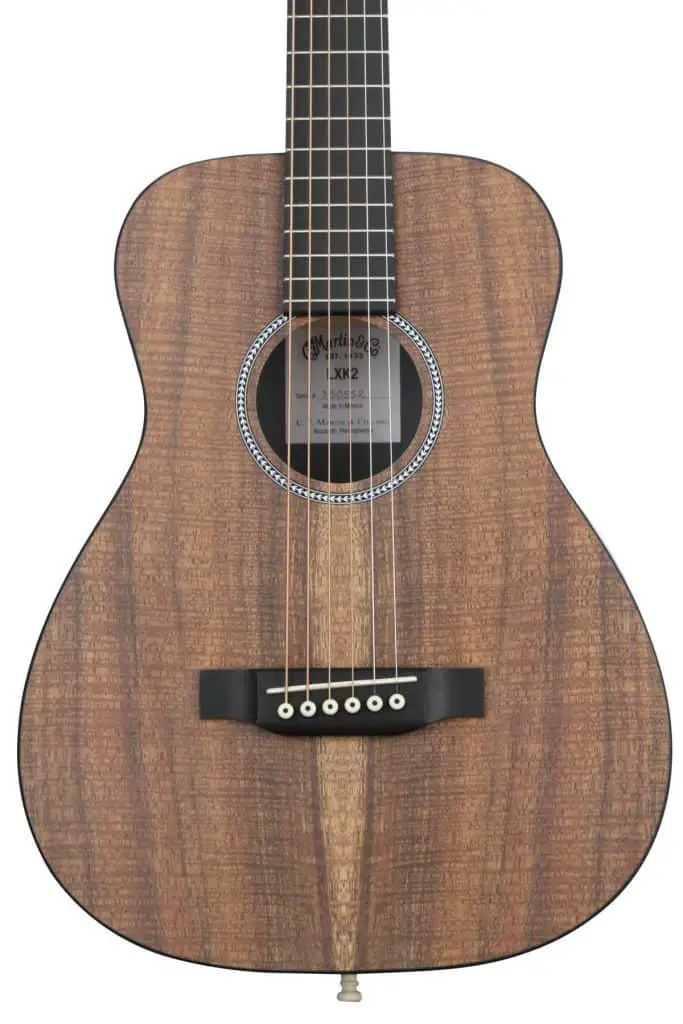
The LXK2 Little Martin packs the same quality and attention to detail as its larger siblings into a light, portable package. The body is made out of a koa-grained HPL on the top, sides, back, and headstock. This high-pressure laminate construction is durable, sounds great, and provides a great value — bringing one of the best acoustic guitar brands within reach for almost any guitar player.
It’s probably the best acoustic guitar under $600, in my opinion.
Are you shopping for a guitarist with small hands? Check out our review of Martin’s smallest acoustic guitar.
Rounding out the features on the Martin LXK2, you’ll find a rosewood fretboard and bridge, a Richlite fingerboard, and a Stratabond neck.
The high-pressure laminate construction doesn’t come without its detractors. Some players swear by solid wood top construction (and tone) over HPL. Other guitarists like the tone but love the durability.
- Little guitar, big tone. Portable and powerful parlor guitar.
- Durable. Koa grain HPL construction is tough and rugged.
- Exceptional value. A Martin acoustic for $369? Yes, please.
- Is an HPL guitar right for you? Some guitarists prefer the sound of a solid spruce top over the laminate construction.
Live with kids or pets? Rough on your guitars? Have you been known to leave your guitar in the trunk of your car overnight? The koa grain high-pressure laminate body will more than stand up to the rigors of the road.
The LXK2 Little Martin also comes with a padded gig bag, constructed with a rugged exterior and plenty of storage compartments.
If you want a big acoustic tone from a small acoustic guitar, look no further than the Martin LXK2 Little Martin. At $369, the Little Martin is not only a good value acoustic guitar from Martin; it’s a good value guitar, period.
• • •
Best Acoustic Guitars — Mid Range
Moving into the mid-range section of this review, you’ll start to see guitars with upgraded features and finishes and a slightly higher price tag.
Epiphone Hummingbird

There’s no mistaking the classic Gibson Hummingbird. From the classy Faded Cherry Sunburst Finish to the trademark “hummingbird” pickguard and elegant split parallelogram inlays, the Epiphone Hummingbird carries on its legacy with all the great Hummingbird looks at a fraction of the price.
The Epiphone Hummingbird comes with the tried and true combination of a solid spruce top, a mahogany body, and a set mahogany neck. When properly cared for, the spruce top should age gracefully and sound even better as it gets older.
The mahogany body adds a rich underlying layer of depth. The pau ferro fretboard provides a playing surface that’s similar in appearance but harder than rosewood. Pau ferro is smooth and easy to play with a brighter tone than rosewood fretboards. But let’s be honest, the first thing you notice when you see this guitar is the classic hummingbird pickguard.
- Iconic Hummingbird looks. A classic, beautiful design.
- Upgraded features. Tried and true tonewoods and upgraded tuners.
- Onboard electronics. Plug in and play with the included Fishman preamp.
- Hardware. Some players have complained about hardware issues. If you’re concerned, try one before you make a purchase.
The Grover 14:1 ratio tuners will hold steady as you tune the Epiphone Hummingbird. For occasions where you need to plug into a PA or recording console, the Epiphone Hummingbird features great-sounding Fishman electronics.
There are some reports of hardware issues, such as the end pin jack falling out. My standard disclaimer still applies here. If possible, I recommend playing the guitar before buying and/or getting your guitar professionally set up by a local guitar tech. That will go a long way towards ensuring that your guitar will be good to go for the long haul.
You’ll love the Epiphone Hummingbird if you want a solid tone and classic Gibson Hummingbird looks on a budget.
You also might want to check out our earlier look at the Epiphone Hummingbird in our review of the Best Cheap Acoustic Guitars.
• • •
Taylor GS Mini Mahogany

One of life’s challenges on the road, whether for work or even vacation, is spending time away from your guitars. Enter the Taylor GS Mini Mahogany, where its 23.5” scale length and more petite body make it easy to pack and bring along with you — wherever your travels take you.
As soon as you give it a strum, you’ll notice there’s nothing “mini” about the Taylor GS Mini Mahogany’s sound. Outfitted with a tropical, solid mahogany top, layered sapele back and sides, and an ebony fretboard, this guitar is designed for serious projection and rich tone.
The tropical mahogany top gives you the classic deep, rich acoustic tone that sounds incredible coming out of the miniature guitar. The layered sapele back and sides are similar to mahogany sound-wise, with a bit of extra sparkle on the high-end treble frequencies. This combination of tonewoods gives you a remarkably balanced tone.
- Portable. Thanks to its scaled-down length and body size.
- Surprisingly loud. Excellent projection with a well-rounded tone.
- High-quality tonewoods. As you’d expect from a Taylor guitar.
- Higher price for a mini guitar. But it sounds so good!
If you’re not familiar with Taylor guitars, The GS Mini Mahogany is a prime example of why they’re so popular. You’ll find high-quality construction, contemporary refinements, and upgraded features that make their acoustic guitars look and sound amazing. At $599, this smaller-bodied acoustic might be one of the best acoustic guitars under $1,000 in today’s market.
Intrigued by the size and tone of the GS Mini Mahogany but need onboard electronics? Check out our Taylor GS Mini-e rosewood review in our best cheap acoustic guitars article.
• • •
Yamaha A1M Dreadnought

The Yamaha A1M Dreadnought is one of the few dreadnought body shape designs in this review with a cutaway. This gives you open access to the upper frets for solos and noodling to your heart’s delight.
Suppose you haven’t read our article on The Best Yamaha Acoustic Guitars For Every Player and Every Budget. In that case, it’s time for a Spoiler Alert: We’ve been consistently impressed with the high level of quality and reasonable prices we’ve seen in recent Yamaha acoustics guitars. The A1M Dreadnought is no exception.
The Yamaha A1M Dreadnought features a solid Sitka spruce top, solid mahogany back and sides, rosewood fingerboard, mahogany neck, and a rosewood bridge. Using their scalloped bracing technique, you’ll find an even greater bass response for deep, warm tones with the bright sparkle and definition from the solid top acoustic guitar.
- Striking vintage looks and tone. Best of both worlds.
- Robust onboard electronics. Volume, EQ, and tuner are all handy additions.
- Western cutaway. Easy access to the upper frets for solos.
- Overcoming the stigma. If your gut reaction is to gloss over a Yamaha acoustic guitar, you owe it to yourself to check this out.
Under the hood, you’ll find Yamaha’s famed SRT pickup and System 66 preamp. In addition to the preamp, the A1M Dreadnought also features an onboard tuner, 3-band equalizer, and a cool automatic midrange frequency control.
Once again, Yamaha delivers a best-of-both-worlds guitar — pairing classic vintage looks with excellent tonewoods and onboard electronics. The Yamaha A1M Dreadnought is my pick for the best acoustic guitar for intermediate players, but at $569.99, it’s well within reach for players of all backgrounds and abilities.
• • •
Martin SC-10E
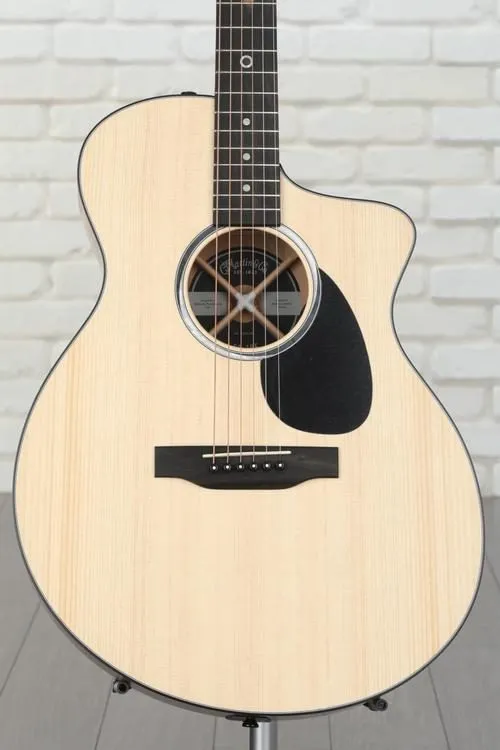
The SC-10E doesn’t really look like a Martin acoustic guitar from a distance. Best known for its legendary time-tested designs, the SC-10E bucks Martin’s traditional styling for modern features, electronics, and playability.
The first thing you’ll notice is the SC-10E’s unique body shape. Its offset, s-shaped body is designed to be very comfortable against your body. The Martin SC-10E features several additional features with comfort in mind, including a sloped bridge and a low-profile neck with a heel-less design.
While the SC-10E is definitely a departure from Martin’s more traditional designs, you’ll still find the same high-quality tonewoods. The SC-10E still nails that pure Martin acoustic tone, featuring a Sitka spruce top and koa on the back and sides. And thanks to scalloped X-style bracing, you’ll find fantastic projection and volume.
- S-shaped body. Very comfortable to play
- Sloped bridge. Dramatically reduces accidental bumps.
- High-quality tonewoods. Just as you would expect on a Martin guitar.
- Revolutionary design for a Martin. Might scare some guitarists away.
Under the hood, the Martin SC-10E has a Fishman MX-T electronics system with a built-in tuner. This discreet sound hole pickup sounds pure and natural. The onboard tuner mutes the audio output if you need to tune up once you’re plugged in. Because let’s face it, nobody wants to hear you tune your guitar.
The SC-10E blends Martin’s legacy of high-quality acoustic guitars with modern amenities if you’re looking for a feature-packed acoustic-electric guitar. The neck shape, low action, and heel-less design feel right at home for electric guitar players, regardless of what genre you play.
If you’ve always wanted a Martin but really wanted something more modern, the SC-10E is an excellent choice.
• • •
Gibson G-45
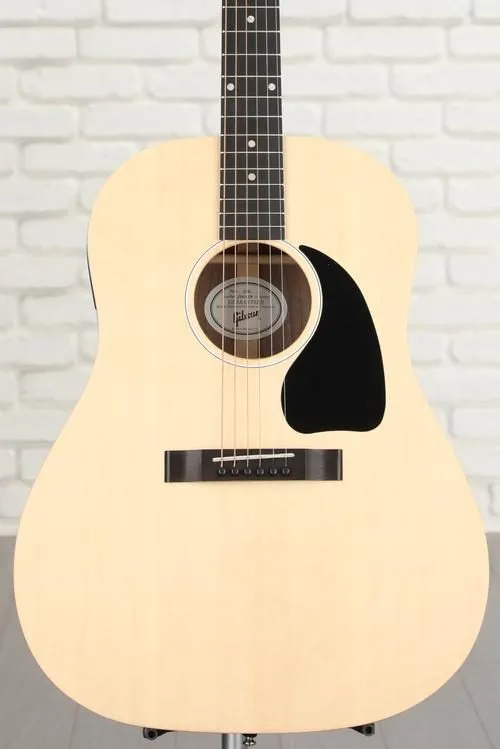
The Gibson G-45 is a stripped-down, straightforward acoustic guitar made in the USA at Gibson’s Montana factory. At $1,199, the G-45 is positioned as a less expensive gateway into the world of Gibson acoustic guitars. Still too rich for your blood? Let’s take a look and find out.
The first thing you’ll probably notice once this guitar is in your hands is the oval on the side of the G-45. Gibson calls this the Player Port. The Player Port routes the sound through the same body passages where the rest of the resonance is created and funnels the sound up and towards your ears.
You might think you have no issues hearing a traditional acoustic guitar while you play, but it’s a unique experience you won’t truly understand until you try out this guitar.
The Gibson G-45 features a solid Sitka spruce top alongside a walnut back and sides. The walnut back and sides retain a strong bass and midrange response while harmonizing well with the Sitka spruce top for sparkle and clarity.
- Relatively affordable for a Gibson. $1,199 street price.
- Made in the USA. Alongside Gibson’s high-end acoustics.
- Player Port. Don’t knock it until you try it — this is actually pretty cool.
- It’s different. If you want a more traditional Gibson acoustic, some of the features and finishes might turn you off.
The neck on the Gibson G-45 is constructed from utile, which is similar to mahogany in feel and tone. Paired with an ebony fretboard, this is a seriously smooth-playing guitar. While there are no onboard electronics on the Gibson G-45, the solid combination of tonewoods sounds great when mic’d up if you’re a performing musician.
I realize that I may have lost you at the beginning of our review of this guitar when I referred to it as “entry” level for a Gibson. I like how Gibson experimented with some different features on the G-45 rather than simply taking away parts from their more expensive models.
Paired with more standard features, such as its solid Sitka spruce top, the Gibson G-45 is a compelling offering that is undeniably more affordable than the rest of Gibson’s acoustic guitars.
• • •
Martin 000-15M

Widely seen as one of the best acoustic guitar brands, the Martin 000-15M is an entry-level guitar with many higher-end features.
The Martin 000-15M is an all-mahogany tone machine from head to toe—or from its body, back, and sides to its neck. This all-mahogany construction gives it a massively warm tone that’s equally great for strumming or fingerpicking.
The Martin 000-15M’s tonewood selections include a solid East Indian rosewood fingerboard atop a “modified low oval” mahogany neck.
This guitar might not look like traditional Martin guitars, but its dark satin finish is undeniably cool. Understated elegance is the game’s name here, with subtle fretboard inlays complementing the 000-15M’s monochromatic aesthetic.
- Killer tone. Mahogany construction gives you a deep, rich sound.
- Cool stripped-down appearance. Smooth satin finish looks and feels great.
- Great value for a Martin acoustic. It’s hard to compete with a reasonably priced Martin!
- Price. There’s no denying it’s an excellent value for a Martin, but it’s still priced at the higher end of our mid-range guitars.
When we call this a mid-range guitar, you might scoff at the $1,349 price tag, but it’s truly an excellent value for any acoustic, let alone a Martin. You’ll be hard-pressed to find a selection of solid woods and quality construction at this price or even higher. It’s one of the best acoustic guitars in this price range.
Are you primarily a fingerstyle player? Check out our review of the Martin D-15M in our best fingerstyle guitar article.
• • •
Takamine Legacy EF341SC

The Takamine Legacy EF341SC is a serious workhorse guitar ideal for performing live and recording. Its dreadnought guitar body shape — with a beautiful black finish — features easy access to the highest frets. The onboard electronics make this acoustic guitar an excellent pick for performing musicians.
The Legacy DF341SC is a handcrafted acoustic-electric guitar with a solid wood (cedar) top and maple back and sides. While cedar is most commonly found on classical guitars with nylon strings, it’s a tonewood that’s responsive to your playing. This responsiveness makes the Takamine Legacy EF341SC a tremendous acoustic-electric guitar for fingerstyle.
The Legacy EF341SC comes loaded with Takamine’s proprietary Palathetic under-saddle pickup and CT4b II preamp. This preamp includes a 3-band equalizer and lets you dial in a tremendous acoustic-electric guitar tone from an amp or PA system. The onboard electronics also include a tuner to quickly check your tuning during practice or performance.
- Gig and studio-ready. Thanks to robust onboard electronics.
- Packed with features. Comfortable to play, beautiful black finish, lots of tonal controls.
- Emphasis on quality. Handcrafted with top-notch tonewoods.
- Amplified tone is a bit on the mellow side. It might not be for everyone, but the EQ can help you dial in your tone.
While I wouldn’t rule out the Takamine Legacy EF341SC for beginners, it’s an instrument primarily geared toward performing musicians.
If you’re looking for an absolute workhorse of an acoustic guitar with solid wood selections, great-sounding onboard electronics, and accessible playability, you’ll love the Takamine Legacy EF341SC. It’s one of the best guitars for performing musicians.
• • •
Fender Acoustasonic Player Telecaster

Now for something very different: The Fender Acoustasonic Player Telecaster. It is a hybrid acoustic-electric guitar that genuinely shines when plugged in. However, this guitar’s natural resonance is quite good, thanks to some familiar acoustic tonewoods.
The Fender Acoustasonic Player Telecaster features a solid Sitka spruce top, mahogany body, and a modern “Deep C” shaped solid mahogany neck topped with a rosewood fretboard. The Acoustasonic Player Telecaster’s thin body has a smooth satin polyester finish that’s comfortable to play and looks great. Speaking of comfort, you need to feel the modern Deep C neck to believe how easy it is to play.
Thanks to the tried and true combination of renowned acoustic guitar tonewoods, you’ll probably be surprised — if not satisfied — with the unplugged tones you can conjure from the Fender Acoustasonic Player Telecaster. However, it begins to shine once you plug it into an amp, PA, or soundboard.
At first glance, you’ll notice that the guitar’s body and the slanted single coil-style pickup bear a striking resemblance to an electric Fender Telecaster. This bridge pickup is called Fender’s N4 magnetic pickup.
The N4 pickup lets you tap into more traditional electric Telecaster tones. A Fishman under-saddle piezo pickup powered by a single 9-volt battery delivers more conventional acoustic-electric tones.
- Best of both worlds. Electric guitar playability and comfort with acoustic tones.
- Wide range of tone control. Thanks to bridge and under-saddle pickups.
- Surprising punch for a hybrid. Not bad as a standalone acoustic guitar in its own right.
- Polarizing design. Some players can’t get past the style of the Acoustasonic Player Telecaster.
Using a familiar 3-way switch and a blend knob, you can mix up the tones from each pickup for a truly unique tone. Want to add some vintage crunch? Clean Nashville-style picking? Traditional, warm acoustic tones? You can tap into all of these tones and more with the flick of a switch.
Let’s be honest. This guitar is not for everyone. It’s hard to judge it among the best acoustic guitars simply because it’s so different from the rest of the traditional-styled acoustic guitars in this review.
But suppose you’re a performing or recording musician. In that case, the Fender Acoustasonic Player Telecaster packs a ton of tonal options into one guitar — no need to haul different acoustics and electrics to the gig or studio anymore.
Suppose you frequently play acoustic guitars through an amp, PA, or soundboard. In that case, you owe it to yourself to at least pick up and play the Fender Acoustasonic Player Telecaster acoustic-electric guitar. It’s a highly versatile guitar that’s a lot of fun to play.
• • •
Best Acoustic Guitars — Best Of The Best
If you want the best acoustic you can buy, this section is for you regardless of budget. We’ve taken a look at the best of the rest in the entry and midrange levels. Now it’s time to dive into the best of the best.
Martin HD-28

Sweetwater refers to the Martin HD-28 as “the Ultimate Dreadnought from Martin,” and it’s hard to argue with that statement. Building off of the legacy of the legendary Martin D-28, widely viewed as one of the best acoustic guitars of all time and made famous by players like Bob Dylan, the HD-28 acoustic guitar brings a herringbone pattern on the top of the guitar (hence the “H” in HD-28) and scalloped X-bracing under the hood.
Everything about the Martin HD-28 is premium. From the solid Sitka spruce top, East Indian rosewood sides, and back and ebony fretboard, Martin has taken the best of their best features from their long, rich history and applied them to a stunning-looking — and sounding — acoustic guitar.
You’ll find yourself right at home with the Martin HD-28 whether you play with a pick, fingerstyle, or a combination of the two.
- Top-notch craftsmanship. Flawless build quality from top to bottom.
- Elegant touches. Herringbone top trim and diamond fretboard inlays.
- Amazing tone. Rich and impeccably well balanced.
- Price. Yeah, it is expensive. But it’s incredible.
As I touched on earlier, if you’re wondering what the “H” in HD-28 stands for, take a close look at the body and check out the incredible herringbone pattern in the finish. Everything about this dreadnought guitar oozes quality, class, and sophistication — down to the intricate diamond fretboard inlays, an ebony bridge, high-quality tuning pegs, and the impeccably balanced tone.
Overall, the Martin HD-28 is one of the best acoustic guitars you can buy. Period.
We’ve also reviewed the OG: The Martin D-28 in our Best American-Made Guitars article. Check it out!
• • •
Taylor American Dream AD27e
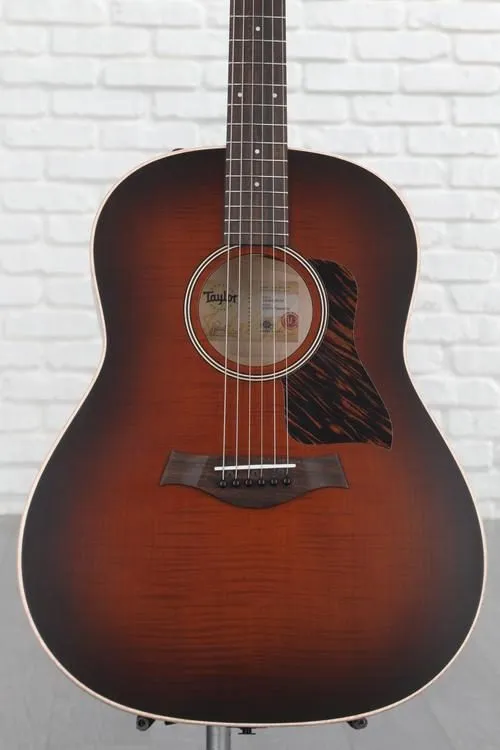
Perhaps most widely known as one of the best acoustic guitar makers of modern acoustics, the American Dream AD27e Flametop A/E guitar proves that Taylor can seamlessly blend vintage looks with cutting-edge features.
The flamed maple top is the headliner here, giving this classic dreadnought-style guitar a modern look. The Taylor American Dream AD27e features an all-maple construction on its back, sides, and neck.
As far as acoustic guitar tonewoods go, maple falls on the brighter side of the tonal spectrum. It has a bright, lively tone that sounds great, although some acoustic guitar players might prefer a different tonewood complement overall.
The maple neck feels great — a familiar feel for players who might spend more time with their electric guitars. Speaking of the AD27e’s neck, Taylor’s legendary neck design ensures that you’ll always have correct string tension and easy playability.
The American Dream AD27e features Taylor’s trademark V-Class bracing. V-Class bracing combines rigidity with flexibility, resulting in excellent tone, projection, and solid intonation. Since the V-shaped bracing runs parallel to the string path, it gives your guitar better sustain. If you’ve never played a Taylor with V-Class bracing, you’re in for a treat.
- Showstopping appearance. The flamed maple top stands out from the crowd.
- Classic shape with modern features. A familiar dreadnought-style shape blends beautifully with Taylor’s onboard electronics.
- Great neck. Maple neck with eucalyptus fingerboard.
- Maple construction. While the flamed maple finish looks killer, some players prefer other tonewoods on their acoustics.
The AD27e features Taylor’s signature ES2 electronics system. This under-saddle pickup helps the bright maple tone shine in the studio or on stage. You already know that Taylor guitars are known for their great-sounding plugged-in tones if you’re reading this. The AD27e does not disappoint.
The Taylor American Dream AD27e Flametop is a testament to Taylor’s ability to meld classic and modern features into an incredible-sounding instrument perfectly. Built in the United States, Taylors are legendary for their thoughtful designs and impeccable quality.
In my opinion, the AD27e threads the needle if you’re looking for a vintage-styled acoustic guitar loaded with modern features.
I’ll be honest: I’m not a huge fan of flamed maple acoustic guitar tops, but Taylor did a great job of not going too over-the-top with the AD27e. It’s yet another example of one of Taylor’s many high-end guitars. A classic dreadnought-style shape with killer features and finish — what’s not to like?
• • •
Gibson J-45
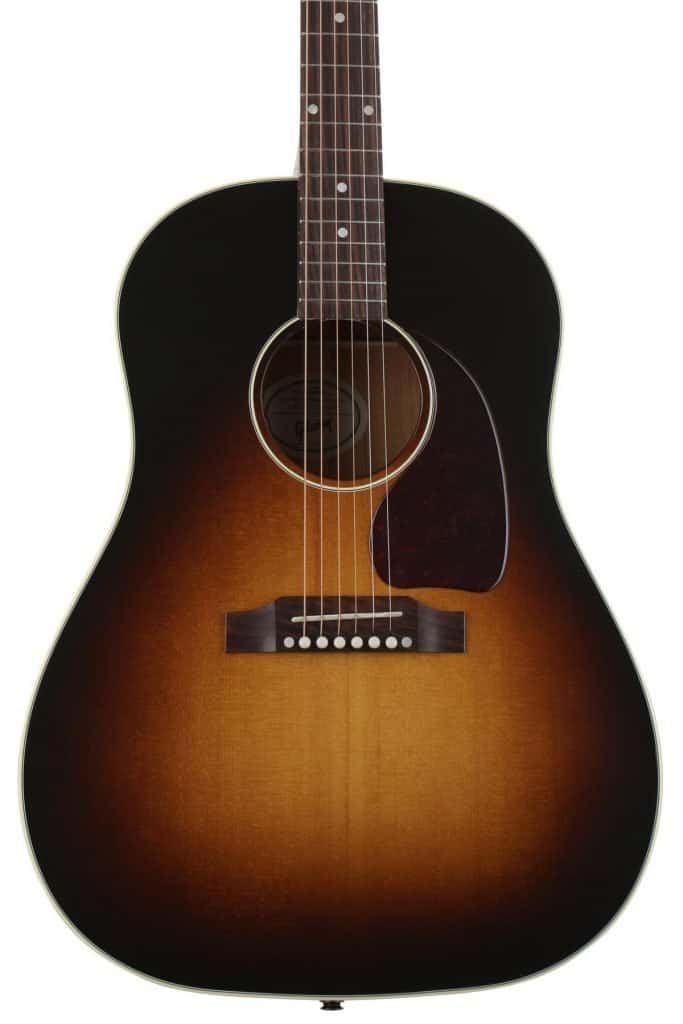
Another acoustic stalwart is the legendary Gibson J-45 Standard. It’s lovingly referred to as “The Workhorse” thanks to its blend of quality construction and great-sounding tonewoods — not to mention that it’s appeared on countless recordings and stages.
The Gibson J-45 Standard has a solid Sitka spruce top and mahogany back and sides. Hard to go wrong with that combination. Hand scalloped X-bracing provides solid support and produces excellent projection. The compound dovetail neck joint gives this workhorse a lot of stability and a high grade for overall build quality.
One of the features that make the Gibson J-45 stand out is its sloped shoulder. Sloped shoulder dreadnought guitars are not just comfortable to play; they also help with projection and low-end response.
If you want pure, unadulterated acoustic guitar tone when you plug into a PA or soundboard, you’ll love the onboard LR Bagg’s VTC acoustic pickup system.
Personally, I vastly prefer the sound of this system over piezo pickups — to me, it just sounds more natural. Your preference may differ, but the discreet design and easy access via the endpin jack make this pickup system a clear winner in my book.
- Legendary tone. Heard on countless recordings, it’s hard to go wrong with a Gibson J-45.
- LR Baggs VTC soundhole pickup system included. For amazing amplified sound.
- Excellent playability. Thanks to a high-quality rosewood fingerboard with rolled edges.
- Limited tone controls when plugged in. No 3-band EQ.
Full disclosure: I am personally a huge fan of the Gibson J-45, and in my opinion, it might be the best acoustic guitar out there. However, I actually own the J-45 Studio version with a different combination of tonewoods and appointments.
The biggest question you’ll have to ask yourself when shopping for a J-45 is whether or not the Standard version feels like it’s worth the $650 difference. It’s hard to go wrong either way — the Gibson J-45 is seen as one of the best acoustic guitars of all time for a reason.
• • •
Martin D-35 Dreadnought

Let’s cut right to the chase. The Martin D-35 is one of the best acoustic guitars of all time. Legendary for its combination of good looks, phenomenal-sounding tonewoods, and great playability, what’s not to like?
The Martin D-35 features a Sitka spruce rob, East Indian Rosewood back and sides, and an ebony fingerboard. The harmonic balance that you find with the combination of the Sitka spruce clarity and the deep, rich bass from the rosewood truly needs to be heard to be fully appreciated. The D-35 features forward-shifted X-style bracing that channels your string vibrations forward for tons of projection and a louder sound.
Not only does the Martin D-35 look and sound great, but it’s also an absolute joy to play. Martin uses a “modified low oval, high-performance taper” neck shape that feels great in your hand. The beautiful, bound fretboard has been Plek’d, making the D-35’s playability as smooth as silk.
- Perfect sound quality. Thanks to an excellent tonewood selection.
- Plays like a dream. Plek’d ebony fretboard is smooth and responsive.
- Three beautiful finishes. Natural, Ambertone, and Sunburst make the D-35 look as good as it sounds.
- No onboard electronics. The D-35 is true to its roots, so you won’t find a pickup or tuner here.
The Martin D-35 is not only one of the best acoustic guitars on the market today, and it’s one of the best acoustic guitars of all time. The D-35 does not deviate from its legendary heritage, so you will not find any onboard electronics here.
Sure, it’s not cheap at $3,199, but the Martin D-35 is a fantastic guitar. It’s simply one of the best acoustic guitars you can buy.
• • •
Taylor 814ce
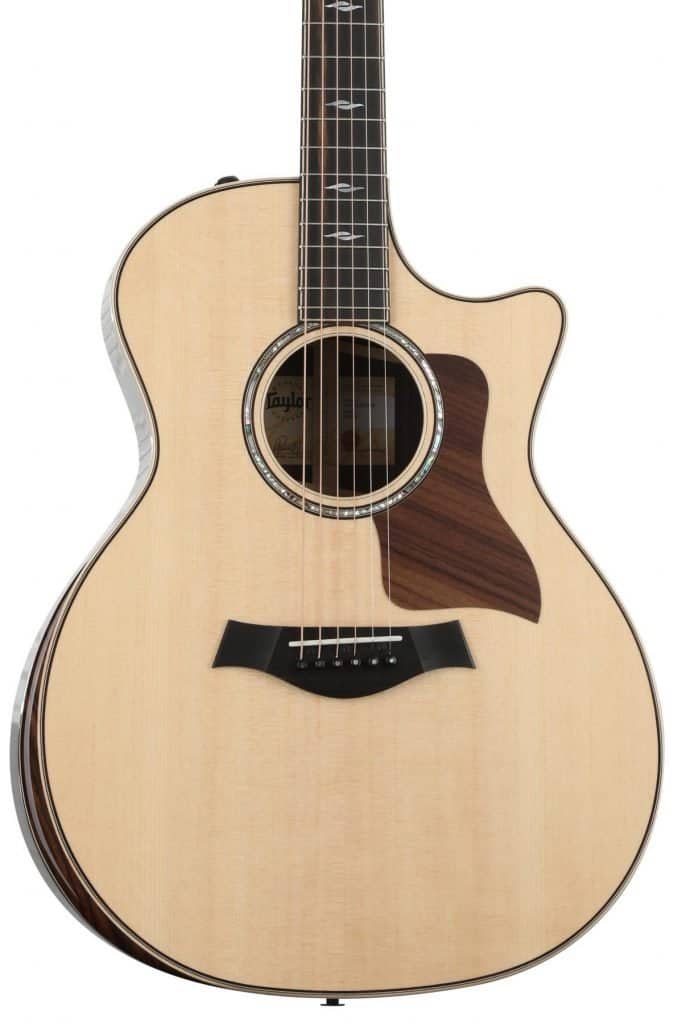
The Taylor 814ce is an acoustic guitar that commands your attention visually and sonically. The 814ce features a Grand Auditorium body style, similar to a dreadnought body but provides incredible projection and unfettered access to the upper frets thanks to its elegant Venetian cutaway.
No expense was spared in the selection of the Taylor 814ce’s tonewoods. Featuring a Sitka spruce top, Indian Rosewood on the back and sides, and a West African ebony fingerboard and headstock, the Taylor 814ce is handmade in California with the finest components.
What makes the Taylor 814ce stand out is one of the features you can’t see. Its V-Class bracing helps improve your overall tone, keeps your intonation more stable and helps increase sustain. It also creates a more significant response when playing fingerstyle or with a pick.
Speaking of fingerstyle playing, take a look at another review of the Taylor 814ce in our Best Fingerstyle Guitar article.
- Premium tonewoods. For incredibly well-rounded acoustic tone.
- V-Class bracing. Improves tone, intonation, and sustain.
- Commanding, consistent tone, whether you’re plugged in or not
- Piezo-style pickup. Some guitarists have a strong aversion to piezo-pickup tone.
The 814ce features Taylor’s Expression System 2 pickup system. Housed under the saddle, the ES-2 system gives you clean and clear piezo-style tones with controls to adjust the high and low frequencies. Another valuable and unique feature in the ES-2 is a polarity switch that allows you to eliminate feedback.
The Taylor 814ce is one of the best acoustic guitars available today. With its top-notch build quality, high-quality tonewoods, and Taylor’s tone sculpting Expression System 2 pickup system, it’s a serious contender for the title of best acoustic guitar.
• • •
Taylor 324ce

Since we’re looking at the Taylor 324ce immediately after reviewing Taylor’s 814ce, it’s hard not to compare the two. Both guitars feature quality tonewoods, great-sounding onboard electronics, effortless access to the upper frets, and V-class bracing for added volume and sustain.
There are a handful of key differences, however. The 324ce has an all-mahogany construction, whereas the 814ce employs a mix of solid sitka spruce, mahogany, and ebony. The Taylor 324ce also costs about $1,500 less than the 814ce, making this choice a little more interesting.
The mahogany neck, top, back, and sides on the Taylor 324ce give this acoustic-electric guitar an exceptionally rich and deep tone. Equally great for fingerstyle or playing with a pick, I like the dark hues from an all-mahogany guitar. On the other hand, some guitarists might find the tone a little on the dark side for their taste.
One feature that helps bring some added high-end sparkle to the Taylor 324ce is its V-Class bracing. It adds stability, sustain, volume, and rich harmonic overtones that you need to hear to believe.
- Fantastic finish. The Shaded Edgeburst looks amazing.
- Big, deep tone. Thanks to Grand Auditorium body shape and sound chamber
- Onboard electronics. Includes a very convenient master volume knob and 2-band EQ.
- Dark tone. The all-mahogany construction might be a little too dark for some guitarists.
The Taylor 324ce features the same Expression System 2 (ES2) electronics as the Taylor 814ce. This system is powered by a segment pickup under the bridge saddle and features bass/treble controls and a handy master volume control. The 324ce’s ES2 system also has a built-in phase switch to eliminate feedback.
Overall, the Taylor 324ce packs a lot of the same styling and features as its much more expensive sibling in the 814ce. There’s no denying that both instruments are great acoustic-electric guitars, but they have high-quality acoustic tone and features at two very different price points. If you like darker-sounding acoustic tones, the Taylor 324ce is one of the best acoustic guitars.
• • •
Gibson Hummingbird Original
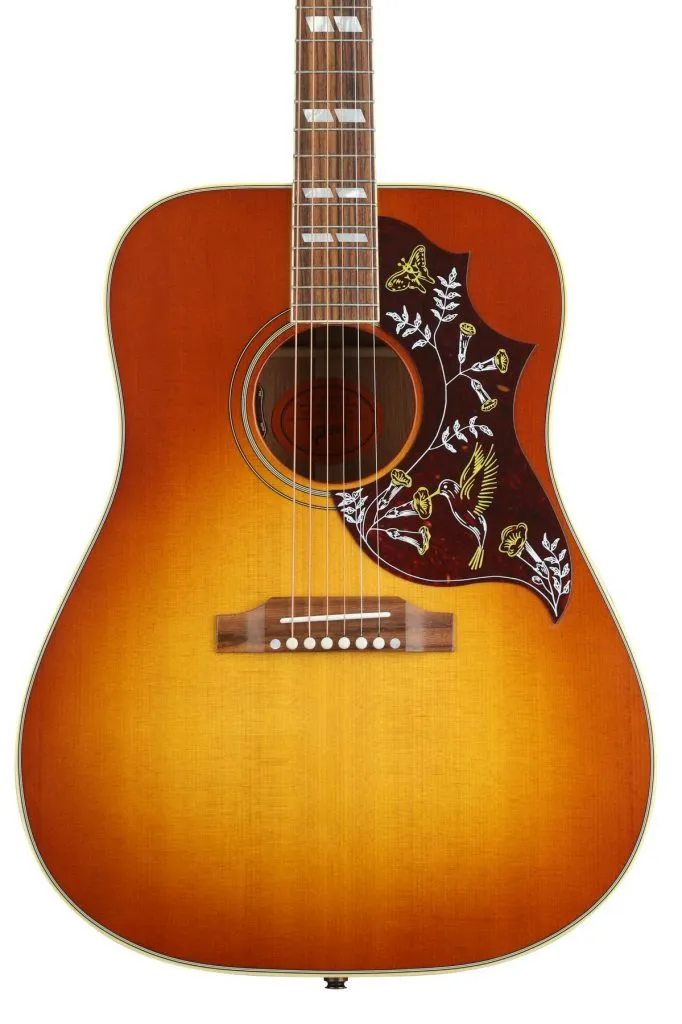
Do you believe in love at first sight? We didn’t hold back in expressing our love for the Hummingbird when we reviewed Epiphone’s version earlier in this article. Believe it or not, the Gibson Hummingbird Original is even more stunning with its vibrant finish, elegant details, and premium tonewood selections.
Like the Gibson J-45, the Hummingbird Original has solid spruce atop a mahogany back and sides and an LR Bagg’s Element VTC pickup system. The similarities between the two acoustic guitar models end here.
Unlike the Gibson J-45, the Hummingbird Original features a square shoulder for a slightly more boxy look (this was a first for Gibson). The gorgeous Heritage Cherry Sunburst finish must be seen in person to be fully appreciated — photos do not do it justice. The proverbial cherry on top is the engraved pickguard with the timeless hummingbird and blossom design.
For good reason, the LR Bagg’s Element VTC pickup system is a go-to on Gibson’s high-end acoustic guitars. It sounds naturally great, connecting the classic tones of the Gibson Hummingbird Original to an amp, PA system, or recording console.
While it sounds killer, there is one downside to the LR Bagg’s Element VTC pickup system: It only features a volume control — no EQ controls. On the bright side, the system is exceptionally discreet, and most casual observers wouldn’t even notice the pickup was there.
- Stunning. Beautiful finish and details.
- High-quality amplified tones. Thanks to LR Bagg’s Element VTC pickup system.
- Premium tonewoods. A beautiful marriage between sitka and mahogany.
- Price to feature ratio. Does its beauty warrant a $4,000 price tag for its (admittedly lovely) features?
There’s no question that the Gibson Hummingbird Original is one of the most legendary acoustic guitars. It’s earned this recognition due to its dependable playability, great tone, and showstopping good looks. Gibson wisely positioned its Epiphone Hummingbird at a mere fraction of the cost of the Hummingbird Original at $449 (as opposed to $4,000).
While I haven’t been shy in sharing my affection for the Gibson Hummingbird Original, it falls a bit short in terms of features compared to the other guitars we reviewed at this price point.
However, if you’re in the market for a Gibson Hummingbird, you’re not looking for a modern acoustic guitar. You’re looking for a faithful recreation of one of the best acoustic guitar models of all time, and Gibson delivers here.
• • •
Buyer’s Guide
Now that we’ve reviewed the best acoustic guitars at every price range, let’s answer some of the most common questions we hear from new and experienced players alike.
Which brand is best for acoustic guitar?
Trying to determine which brand is the best (for you) acoustic guitar depends on three key factors: A) Your budget, B) Your playing style, and C) What you want to use this acoustic guitar for. If you’re brand new to the world of acoustic guitars, I’d recommend the Fender CC-60S Concert (Pack). It may not be the best, but it will equip you with everything you need to get started.
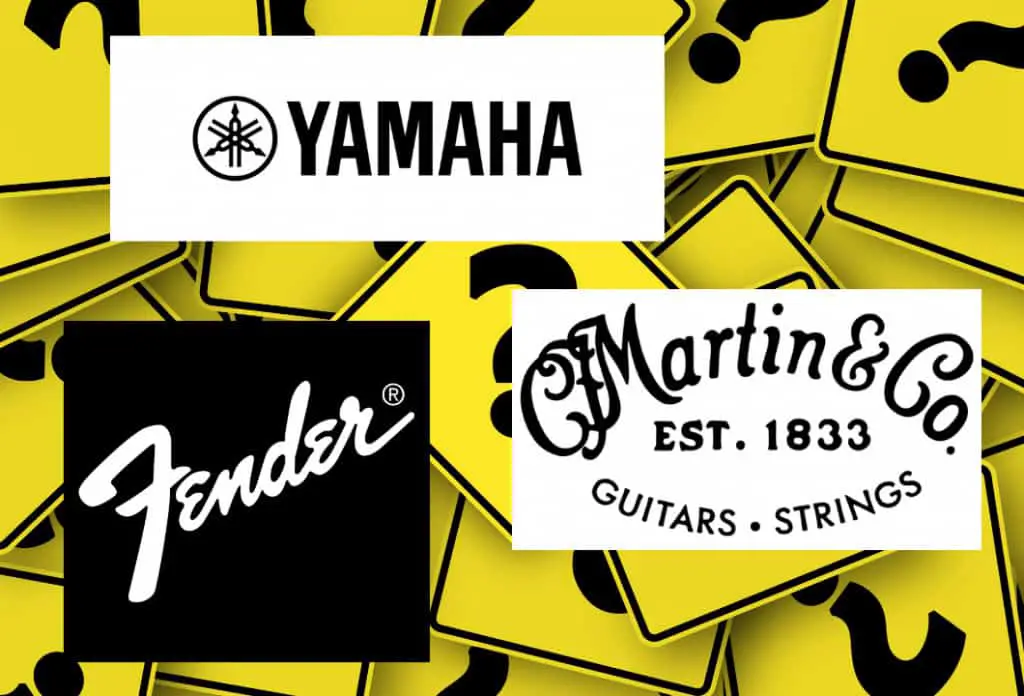
If you’re looking for a recommendation for a specific brand, I suggest taking a long look at Yamaha’s acoustic guitars. Yamaha does a great job of making high-quality instruments with solid wood selections and components accessible to everyone. Whether you’re just learning to play the guitar or looking for a second (or third) acoustic guitar, Yamaha’s line offers affordable options for all players.
It’s hard to have a conversation about the best acoustic guitars without mentioning Martin guitars as one of the leading acoustic guitar manufacturers (1). There’s no denying their status as one of the highest acclaimed acoustic guitar brands. Martin manufactures a couple of my top picks in this review: the Martin HD-28 and the Martin 000-15M.
What is the most versatile acoustic guitar?
I’ll nominate two very different acoustic guitar models for the title of the most versatile acoustic guitar. First the Takamine Legacy EF341SC. It features high-quality tonewoods with a killer black finish, easy access to the upper frets, and a robust complement of onboard electronics to sculpt your tone and ensure you’re staying in tune.

I know this might be controversial, but I’d also nominate the Fender Acoustasonic Player Telecaster as one of the most versatile acoustic guitars. Nowhere else will you find the incredible array of available tones in such a lightweight, comfortable and robust package.
What other acoustic guitar will give you the ability to play a scorching Nashville-hot Telecaster riff at one moment and shift to a lush acoustic rhythm melody with the flick of a switch? I know it’s not for everyone, but it’s a seriously functional instrument that combines the power of both acoustic and electric guitars.
Are high-end acoustic guitars worth it?
Are the best acoustic guitars the most expensive?
We live in an era with an unprecedented number of options for high-quality acoustic guitars. As evidenced by our reviews of both the Epiphone and Gibson Hummingbird models, you can buy a very similar-looking guitar for nearly 1/10 of the price of the high-end model. When you look at Yamaha acoustic guitars, you can get a great acoustic with higher-end features for far less than $1,000.
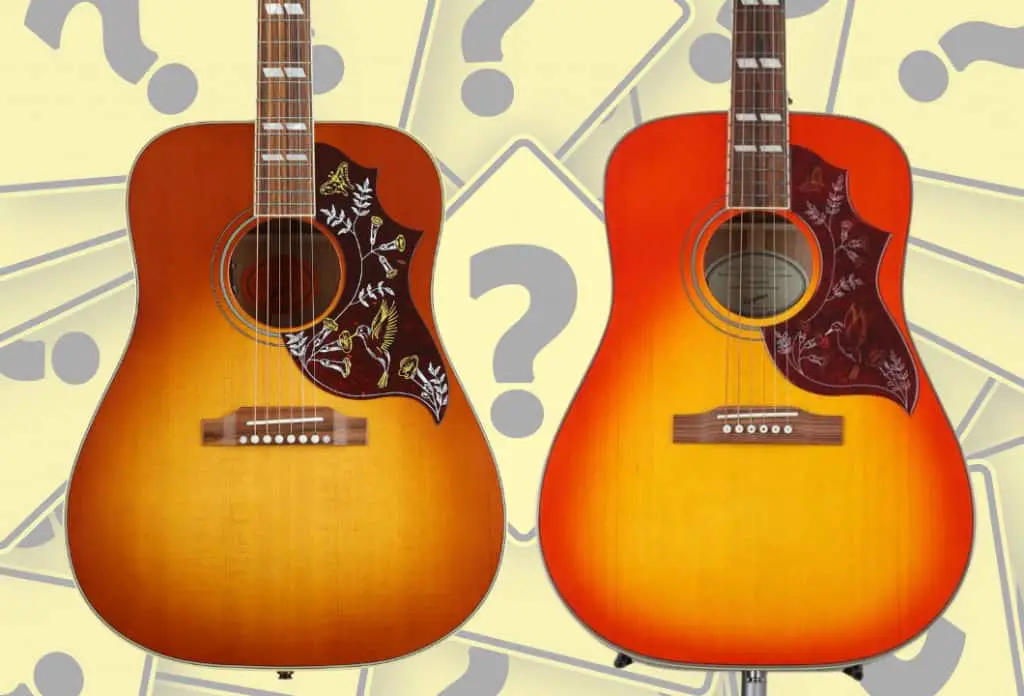
So are high-end acoustic guitars worth it? If they’re worth it to you, then yes.
Aside from enhanced playability, higher quality tonewoods and components, and upgraded pickup systems, high-end acoustic guitars are investments that generally maintain their value. In some cases, depending on the brand, they may increase in value over time.
This is an essential factor to consider when making any guitar purchase — not only do you typically get what you pay for, but you should be thinking about your longer-term plans.
Will you keep it forever? Will you play it for a few years and resell it to fund another purchase? Will you hand it down to your children or grandchildren? These are all critical questions to ask yourself before answering, “Is this guitar worth it?”
• • •
What’s your pick?

Shopping for an acoustic guitar can seem overwhelming, especially if you’re just starting. With so many options, features and prices, we understand that it can be hard to determine where to begin when shopping for an acoustic sound box.
That’s why we broke this review into three categories: Best budget acoustic guitars, best mid-range acoustic guitars, and the absolute best of the best.
Here are my picks for each category:
Best budget Guitar

Pound for pound, the Yamaha FG830 Dreadnought is the best budget guitar when you factor in features, tonewoods, construction, and playability. Honorable mention goes to the Martin LXK2 Little Martin for a scaled-down selection.
Best Mid-Range acoustic guitar

In my opinion, the Martin 000-15M gives you the best mix of quality construction, solid woods, and tremendous tone in the midrange budget bracket. If that’s still too pricey for you, I also like the Taylor GS Mini Mahogany.
Best Overall acoustic guitar

There’s no wrong answer here, but the clear winner is the Martin HD-28, in my opinion. It’s an absolutely flawless dream guitar that you can be proud to own and play for many years. I also mentioned how much I love the Gibson J-45. Taylor makes some of the top acoustic guitars for modern players, and I really like the Taylor 324ce.
Every option in this rundown of the best acoustic guitars will suit you well and bring a new layer of joy to your life. Hopefully, this article will help you find the perfect guitar for you.
• • •
References:
- Martin Guitars, “Two Centuries Of History,” as published here: https://www.martinguitar.com/about-martin-martin-history.html




